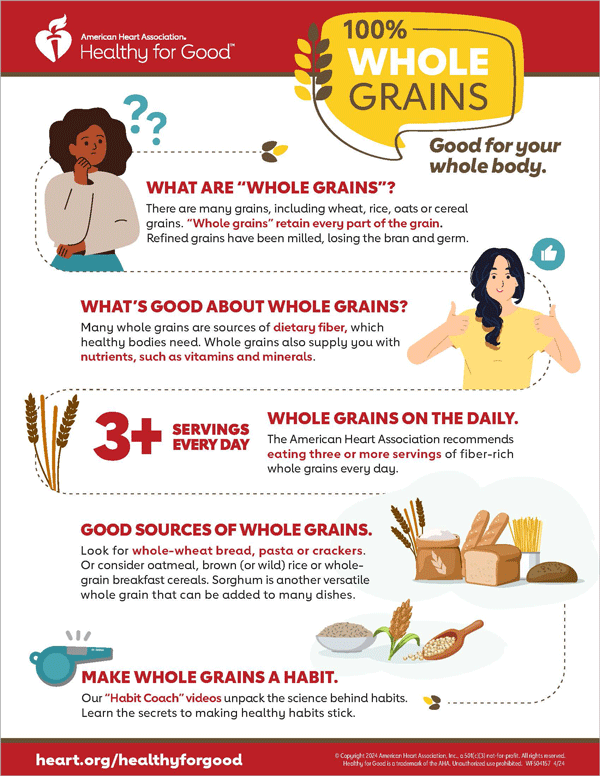100% Whole Grains Infographic
What are whole grains?
There are many grains, including wheat, rice, oats or cereal grains. "Whole grains" retain every part of the grain. Refined grains have been milled, losing the bran and germ.
What’s good about whole grains?
Many whole grains are sources of dietary fiber, which healthy bodies need. Whole grains also supply you with nutrients, such as vitamins and minerals.
Whole grains on the daily.
The American Heart Association recommends eating three or more servings of fiber-rich whole grains every day.
Good sources of whole grains.
Look for whole-wheat bread, pasta or crackers. Or consider oatmeal, brown (or wild) rice or whole-grain breakfast cereals. Sorghum is another versatile whole grain that can be added to many dishes.
Make whole grains a habit.
Our “Habit Coach” videos unpack the science behind habits. Learn the secrets to making healthy habits stick.
View or Download
Whole Grain Infographic (PDF)
Make Meals With Whole Grains
Oat Avocado-Berry Breakfast Bars
This is the perfect breakfast bar for any busy morning. Make ahead and refrigerate to enjoy the next morning or individually wrap and freeze them for a grab-and-go breakfast later in the week.
Chipotle Chicken Bowls with Cilantro-Lime Quinoa
This one-dish wonder provides a protein, whole grain, and vegetables -- a complete meal. With their Mexican flair, these bowls make for a hearty dinner or a portable lunch that's easy to take with you.
Sweet and Sour Pork Fried Rice
Treat your taste buds to this tempting Asian dish bathed in a traditional Chinese flavor combo. The secret to delicious fried rice is making the rice and refrigerating it a day ahead.
Explore Related Resources
- Carbohidratos
- Cocinar para bajar de peso
- Granos y cereales
- Recomendaciones sobre dieta y estilo de vida de la American Heart Association
- Conceptos básicos de nutrición
- Tipos de cereales integrales
- Comprender las etiquetas de información nutricional
- Cereales integrales, cereales refinados y fibra alimentaria


